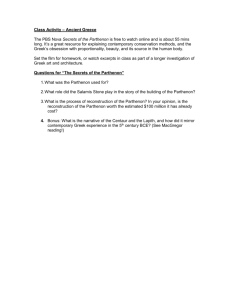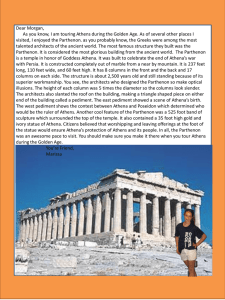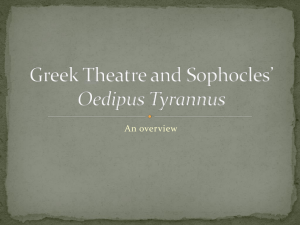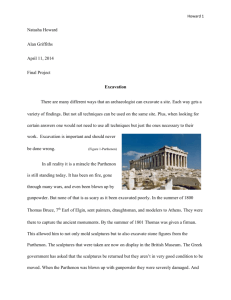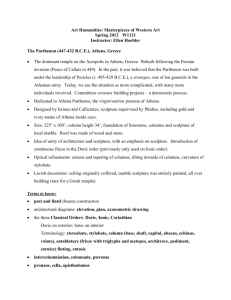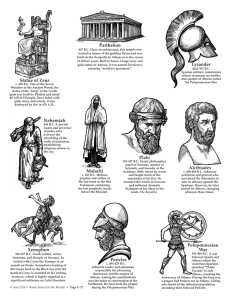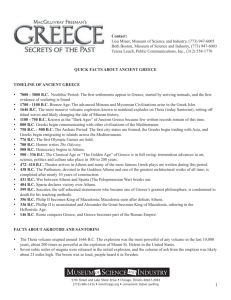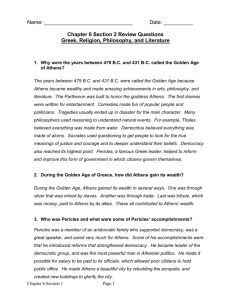Parthenon Reading
advertisement
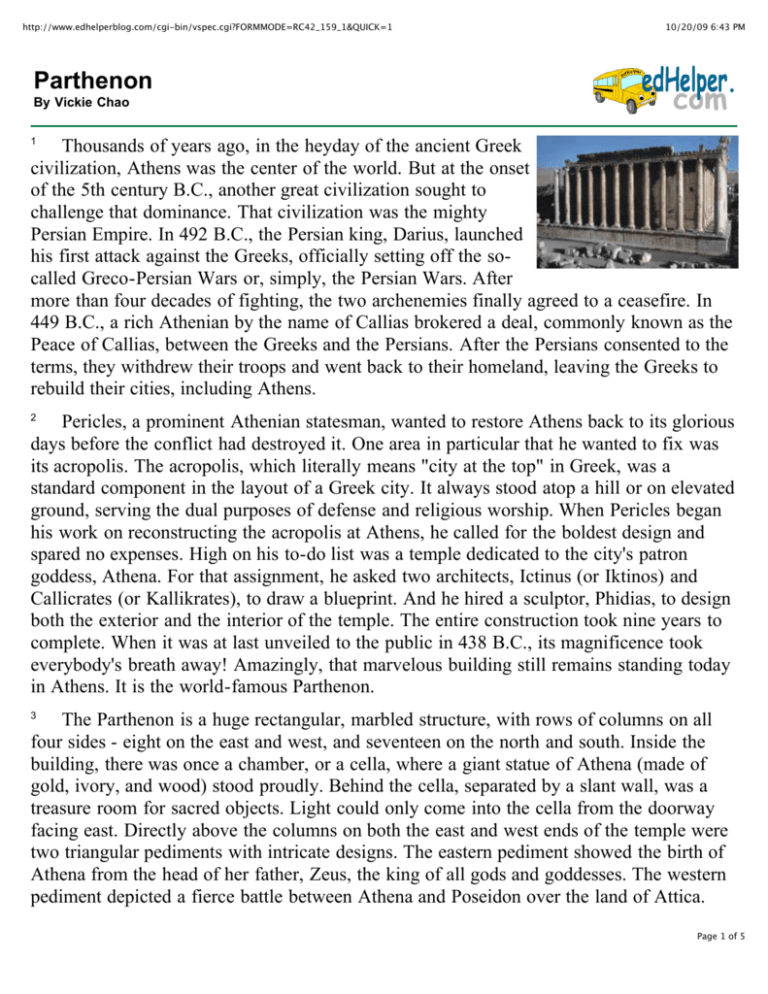
http://www.edhelperblog.com/cgi-bin/vspec.cgi?FORMMODE=RC42_159_1&QUICK=1 10/20/09 6:43 PM Parthenon By Vickie Chao Thousands of years ago, in the heyday of the ancient Greek civilization, Athens was the center of the world. But at the onset of the 5th century B.C., another great civilization sought to challenge that dominance. That civilization was the mighty Persian Empire. In 492 B.C., the Persian king, Darius, launched his first attack against the Greeks, officially setting off the socalled Greco-Persian Wars or, simply, the Persian Wars. After more than four decades of fighting, the two archenemies finally agreed to a ceasefire. In 449 B.C., a rich Athenian by the name of Callias brokered a deal, commonly known as the Peace of Callias, between the Greeks and the Persians. After the Persians consented to the terms, they withdrew their troops and went back to their homeland, leaving the Greeks to rebuild their cities, including Athens. 1 Pericles, a prominent Athenian statesman, wanted to restore Athens back to its glorious days before the conflict had destroyed it. One area in particular that he wanted to fix was its acropolis. The acropolis, which literally means "city at the top" in Greek, was a standard component in the layout of a Greek city. It always stood atop a hill or on elevated ground, serving the dual purposes of defense and religious worship. When Pericles began his work on reconstructing the acropolis at Athens, he called for the boldest design and spared no expenses. High on his to-do list was a temple dedicated to the city's patron goddess, Athena. For that assignment, he asked two architects, Ictinus (or Iktinos) and Callicrates (or Kallikrates), to draw a blueprint. And he hired a sculptor, Phidias, to design both the exterior and the interior of the temple. The entire construction took nine years to complete. When it was at last unveiled to the public in 438 B.C., its magnificence took everybody's breath away! Amazingly, that marvelous building still remains standing today in Athens. It is the world-famous Parthenon. 2 The Parthenon is a huge rectangular, marbled structure, with rows of columns on all four sides - eight on the east and west, and seventeen on the north and south. Inside the building, there was once a chamber, or a cella, where a giant statue of Athena (made of gold, ivory, and wood) stood proudly. Behind the cella, separated by a slant wall, was a treasure room for sacred objects. Light could only come into the cella from the doorway facing east. Directly above the columns on both the east and west ends of the temple were two triangular pediments with intricate designs. The eastern pediment showed the birth of Athena from the head of her father, Zeus, the king of all gods and goddesses. The western pediment depicted a fierce battle between Athena and Poseidon over the land of Attica. Dotted around the temple were numerous forceful, life-like sculptures. Phidias placed them 3 Page 1 of 5 http://www.edhelperblog.com/cgi-bin/vspec.cgi?FORMMODE=RC42_159_1&QUICK=1 10/20/09 6:43 PM Dotted around the temple were numerous forceful, life-like sculptures. Phidias placed them strategically so each section told a different tale of ancient Greece. When Ictinus and Callicrates designed the Parthenon, they employed a secret weapon called the golden rectangle. The golden rectangle, by definition, is one with a ratio of its length to its width equal to roughly 1.6. That particular ratio is an irrational number. In mathematics, it is represented by the symbol of " " or phi. The Parthenon, by itself, is a collection of many golden rectangles. The front of the temple and the spaces between the columns are just two obvious examples. The ancient Greeks believed that a building conforming to the golden ratio would be pleasing to look at. Well, they were certainly right! Even after 2,500 years, the Parthenon continues to draw admiration from people around the world. It is certainly a timeless piece of art and a culmination of the development of the Doric order. (The Doric order is the simplest and the earliest form of the three architectural orders developed by the Greeks. The other two are the Ionic and the Corinthian orders.) 4 For nearly a thousand years, the Parthenon remained essentially intact. But that changed when the Romans decided to convert the temple to a Christian church in the 5th century. They first took the statue of Athena to Constantinople (today's Istanbul, Turkey) and destroyed it there. They then made many more updates so the newly renovated building bore little reference to the pagan god it had once worshipped. After the Turks from the Ottoman Empire seized Athens' acropolis in 1458, they converted the Parthenon yet again to an Islamic mosque. They did not make any significant structural change to the building. The fate of the Parthenon reached an all-time low in 1687. That year, the Venetians attacked the Turks in Athens. On September 26, they bombarded the city. One of their bombs happened to fall on the Parthenon which the Turks were using as a gunpowder magazine. The blast destroyed a great portion of the monument which had actually been preserved in a rather good condition until then. In the early 19th century, another disaster struck the Parthenon. This time, with the permission of the Turks, Thomas Bruce (also known as Lord Elgin), a British ambassador at Constantinople, removed many sculptures from the Parthenon and sold them to the British Museum in London. That final blow literally emptied out the Parthenon, making it the skeletal building that we see in Athens today! 5 Copyright © 2009 edHelper Page 2 of 5 http://www.edhelperblog.com/cgi-bin/vspec.cgi?FORMMODE=RC42_159_1&QUICK=1 10/20/09 6:43 PM Name _____________________________ Date ___________________ Parthenon 1. Which of the following about the Parthenon is correct? It was completely destroyed by the Venetians in 1687. It was commissioned by an Athenian statesman named Pericles. In the 5th century, the Romans dismantled the temple and rebuilt it in Constantinople. It was originally designed as the worship place for Zeus. 3. What architectural order does the Parthenon represent? The Ionic order The Tuscan order The Doric order The Corinthian order 2. Why did the Greeks build the Parthenon? To worship Athens' patron goddess, Athena To serve as a military fortress To serve as a marketplace To worship the king of all Greek gods and goddesses, Zeus 4. Where can we find most of the sculptures originally placed in the Parthenon? The British Museum in London The Guggenheim Museum in Venice The Louvre Museum in Paris The Metropolitan Museum of Art in New York 5. How many religions were worshipped in 6. Which of the following events happened the Parthenon? Two Three Five Four last? The Venetians bombarded Athens. The Romans destroyed the statue of Athena. The Greeks and the Persians signed the Peace of Callias. The Turks converted the Parthenon to a mosque. Page 3 of 5 http://www.edhelperblog.com/cgi-bin/vspec.cgi?FORMMODE=RC42_159_1&QUICK=1 10/20/09 6:43 PM Name _____________________________ Date ___________________ Parthenon 7. Which of the following about Lord Elgin 8. Which of the following about the is incorrect? Lord Elgin was a British. Lord Elgin was once an ambassador stationed in Athens. Lord Elgin's real name was Thomas Bruce. Lord Elgin sold many of the sculptures in the Parthenon. 9. Which of the following had nothing to do with the original creation of the Parthenon? Phidias Callias Pericles Callicrates Parthenon is true? The Parthenon is a triangular building. The front of the Parthenon is the only place that the Greeks applied the golden ratio in their design. The Parthenon used to have an eastern doorway leading to the cella. The Parthenon used to have a cella on top of its roof. 10. What is a golden rectangle? One with its length equal to roughly 1.6 times of its width. One with its circumference equal to roughly 1.6 times of its area. One with its circumference equal to roughly 1.6 times of its length. One with its area equal to roughly 1.6 times of its length. Page 4 of 5 http://www.edhelperblog.com/cgi-bin/vspec.cgi?FORMMODE=RC42_159_1&QUICK=1 10/20/09 6:43 PM Parthenon - Answer Key 1 2 3 4 5 6 7 8 9 10 It was commissioned by an Athenian statesman named Pericles. To worship Athens' patron goddess, Athena The Doric order The British Museum in London Three The Venetians bombarded Athens. Lord Elgin was once an ambassador stationed in Athens. The Parthenon used to have an eastern doorway leading to the cella. Callias One with its length equal to roughly 1.6 times of its width. Page 5 of 5
